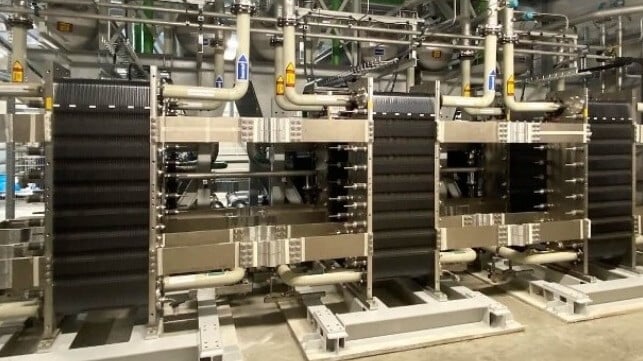E-Methanol and the Future of Marine

As the marine industry looks to decarbonize, with ambitious targets set by the International Maritime Organization IMO 2030 and IMO 2050, new fuels will be part of the solution. But which fuel will it be? Erik Klein, Sustainable Energy Systems, Siemens Energy, talks about how e-methanol fits into the mix and a ground-breaking project with European Energy that has set a new bar in producing this new energy.
The shipping industry is exploring many different solutions to reach its decarbonization targets. New technologies, digital solutions that increase fleet efficiency, and new low or zero-carbon fuels. We need to explore the most obvious options as we don’t have the luxury of time to pick and choose, or to wait and see if one option works before we develop another. Hydrogen, e-methanol, ammonia, and e-methane, are possibilities for powering vessels in the future – but what are the pros and cons of these and, more specifically, what does the future for e-methanol look like?
There will likely be a mix of fuel options to support the future shipping industry. Hydrogen is an exciting fuel for the future and, in liquid form, has three times the energy density of heavy fuel oil. But transporting and storing hydrogen in large volume can be challenging in both liquid and gaseous form. Currently, the way to overcome these challenges is to chemically bind the hydrogen into a carrier thereby easing transportation and storage.
E-methanol is produced from green hydrogen that is created using renewable energy resources. Carbon can also be extracted from industry processes as well as from the air, which would make it climate friendly and contributes to reduced emissions in the short to medium term.
Advancing e-methanol production – project example
The production of e-methanol is currently dwarfed by demand. The project with European Energy has already advanced to a stage that will soon help to meet the growing demand of global integrated logistics companyMaersk, who has a net zero target for 2040. At the same time, it will act as a catalyst for further acceleration of industrial size projects. But why is this project setting a new benchmark, and what does it mean for e-methanol production going forward?
The Kassø project and Maersk agreement
The first large-scale e-methanol production site, commissioned by European Energy, will be installed in Kassø, located west of Aabenraa in the South of Denmark. A highly entrepreneurial business, European Energy has a strong track record throughout Europe in developing wind and photo-voltaic (PV) renewable energy plants. Keen to grow its business further, the company is entering the e-methanol market, where its renewable energy technology can support the development of the world’s largest e-methanol production plant.
The challenges for larger-scale e-methanol production plants include sourcing enough renewable energy on a continuous basis to power the plant processes and finding a viable offtake based on final product prices that are in this early market phase considerably higher than traditional methanol production. To date, it has not been easy to find partners with the courage and knowledge to make such a project a success.
European Energy solved these two challenges early in the project lifecycle by using its wind and PV technology and securing an early agreement with Maersk to take to take most of the offtake. The system utilizes Siemens Energy electrolyzer technology to produce hydrogen, which is fed into a synthesis process where the hydrogen is combined with carbon dioxide to produce methanol.
 Image courtesy Siemens Energy
Image courtesy Siemens Energy
For an industrial-scale plant operating long load hours, the purity of the hydrogen molecules produced, availability and reliability of the electrolyzer system are critical Siemens Energy has invested a great deal in resources for electrolyzer manufacturing with industrial-grade production lines for stacks.
The first electrolyzer array is already in production and is scheduled to be commissioned in Spring 2023. A further two arrays will follow it to complete the 50 Megawatt plant. The project has a tight schedule, but the mechanisms Siemens Energy has put in place to support the expected growth in electrolyzer production, with standardization of stack manufacturing and pre-manufacturing of arrays combined with a very efficient supply chain, means it will deliver as planned.
A strong step forward
Although there have been many visions of large-scale e-methanol production, the project in Kassø is the first to take steps forward in terms of significant scale. It comes at a critical time when, alongside the environmental challenges we face, the war in Ukraine and other geopolitical pressures, supply chain issues, and the need to secure energy supplies are all highlighting weaknesses in the resilience of some countries.
Sustainable fuels are a critical aspect of meeting IMO targets for the shipping industry. Maersk is a first mover in adopting technology as the Kassø plant will provide fuel for its first e-Methanol driven container vessel. By taking this essential step with the offtake agreement, Maersk has enabled the Kassø project to advance. Although initial prices for the e-methanol will be higher, this is a very small percentage of overall fuel consumption. In the future, however, Maersk’s commitment to projects like the one at the Kassø plant will enable further investments, drive costs down and will help start the industrialization of H2 systems and integrated e-methanol plants.
Conclusion
E-methanol is a relatively simple replacement for HFO, with known logistic and storage infrastructure. The Kassø project has shown that, with the right ingredients, it is possible to realize more significant projects and that e-methanol offers a secure, safe, and resilient fuel option for the marine industry. It opens the door to the potential this fuel has to offer, and we hope the success of this project will lead to others investing and the generation of a ‘critical mass’ that will drive down costs and make e-methanol of fully viable fuel for the future of shipping.
The opinions expressed herein are the author's and not necessarily those of The Maritime Executive.
